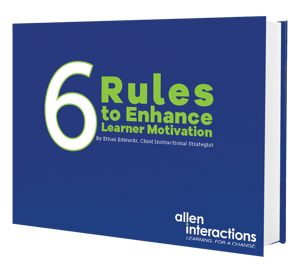Blog
What Happened to e-Learning Instructional Design?
By Ethan Edwards, Chief Instructional Strategist/ @ethanaedwards We often talk about the importance of motivation in e-learning instructional design. ...


Six Achievable & Effective Techniques to Enhance Learner Motivation
By Ethan Edwards | November 10, 2016 | Custom Learning | 0 Comments
By Ethan Edwards, Chief Instructional Strategist/ @ethanaedwards
 We often talk about the importance of motivation in e-learning instructional design. In fact, we’ve even said that motivation is often more important than the specific content when seeking to maximize the impact of instruction—particularly in e-learning, where relatively few social or external environmental factors are likely to inspire learners.
We often talk about the importance of motivation in e-learning instructional design. In fact, we’ve even said that motivation is often more important than the specific content when seeking to maximize the impact of instruction—particularly in e-learning, where relatively few social or external environmental factors are likely to inspire learners.
This has a great deal of surface value, in that motivation is actually a factor in all of human activity. For example, it’s been over 95 degrees here every day for the last week, and my motivation to work outside has plummeted. Of course, lacking motivation affects my level of effort. If willing effort is the only result of creating motivation, then saying that “designing for motivation in e-learning is important” is not really that significant. Of course it’s true, but it is so general a statement that this insight gains us very little in trying to really improve instruction.
But actually, our focus on motivation has very specific importance in instruction. Learner motivation accomplishes five essential goals that are necessary for lasting performance change:
1. Motivation directs behavior toward specific goals.
Performance change involves cognitive and behavioral components. Behaviors change more effectively when those actions are repeated and practiced. But learners choose the goals they will work for based on what motivates them.
2. Motivation leads to increased effort.
Effort enhances meaning, learning, and retention. A motivated learner will always engage in a more energized and directed effort.
3. Motivation increases persistence.
One failure of much e-learning is that learners check out or give up on it. This is largely due to a feeling that there’s no benefit in finishing the course (lack of motivation). The payoff of motivating learners is that they can willingly choose to spend extended time in a learning activity.
4. Motivation enhances cognition.
Motivation determines what learners actually pay attention to. Information processing succeeds or fails based on learners’ attention, which is the first necessary step for meaningful comprehension.
5. Motivation enhances performance.
Quite simply, motivated learners perform better and make choices that are thoughtful, focused, and intentional. This increases retention and transfer beyond the learning environment.
So designing to “enhance learners’ motivation to learn” is way more than an appealing slogan. It truly is at the root of learning. In designing instructor-led technology (ILT), designers have become a little careless, benefiting from the skills of the instructor or the pleasure students find in camaraderie with peers to motivate participation. Once we move to the automated, individualized instruction of e-learning, we as instructional designers have to ensure that learners are motivated to hope to achieve any change.
While it is difficult to motivate all learners equally, some strategies will increase the likelihood of motivating your learners. Below are six of the most achievable end-effective techniques to enhance learner motivation in e-learning. Oddly, these also contradict exactly what is often accepted as good e-learning design.
1. Say less
![]()
So much effort is placed on writing extended content, recording it for narration, and enhancing it through video and digital avatars. Instead, focus less on presenting content and more on getting learners to do something.
2. Increase the challenge
![]() Challenge is motivating; routine, thoughtless gestures are not. Learners respond positively to having their abilities stretched (when they are not being simultaneously punished for failure).
Challenge is motivating; routine, thoughtless gestures are not. Learners respond positively to having their abilities stretched (when they are not being simultaneously punished for failure).
3. Delay judgment
![]() Don’t be so fast to judge learners. When learners have time to consider and evaluate their work, it builds investment and interest in the outcome.
Don’t be so fast to judge learners. When learners have time to consider and evaluate their work, it builds investment and interest in the outcome.
4. Appeal to Emotion
![]() Learning can be elevated when the content you want learners to absorb is connected to elevated emotions beyond simply providing straightforward facts.
Learning can be elevated when the content you want learners to absorb is connected to elevated emotions beyond simply providing straightforward facts.
5. Change the difficulty
![]() Too often, learners get stuck in tedious repetitive tasks, and what they accomplish in these tasks leads to stagnancy. A critical way to break this is to build a success path marked by increased difficulty. Levels and controlled access to help are two of the most effective ways to modify difficulty.
Too often, learners get stuck in tedious repetitive tasks, and what they accomplish in these tasks leads to stagnancy. A critical way to break this is to build a success path marked by increased difficulty. Levels and controlled access to help are two of the most effective ways to modify difficulty.
6. Let the learners take control
![]() The most central thing you can do as an e-learning designer is to let go. Let learners choose the best strategy, sequence, and pace for their efforts. To restrict these choices defeats learners before any learning can happen.
The most central thing you can do as an e-learning designer is to let go. Let learners choose the best strategy, sequence, and pace for their efforts. To restrict these choices defeats learners before any learning can happen.
If you are looking for more resources on learning motivation check out the following resources:
[e-Book & Webinar] Six Rules to Designing e-Learning for Maximum Motivation

In this e-book, Ethan presents six effective design strategies you can leverage to increase motivation. This e-book also includes a design question to think through for each rule.
In this 1-hour on-demand webinar, Ethan lays out six design strategies to increase learner motivation illustrated through several successful corporate e-learning courses.
SHARE THIS BLOG WITH THE READY-MADE TWEET BELOW!
 CLICK TO TWEET: Six Achievable & #Effective Techniques to Enhance Learner #Motivation http://hubs.ly/H057Lrv0 #eLearning
CLICK TO TWEET: Six Achievable & #Effective Techniques to Enhance Learner #Motivation http://hubs.ly/H057Lrv0 #eLearning

About the Author: Ethan Edwards
Ethan Edwards draws from more than 30 years of industry experience as an elearning instructional designer and developer. He is responsible for the delivery of the internal and external training and communications that reflect Allen Interactions’ unique perspective on creating Meaningful, Memorable, and Motivational learning solutions backed by the best instructional design and latest technologies.
Comments
Would you like to leave a comment?
Related Blog Posts

By: Ethan Edwards | Nov, 2014
Category:

Blog
Motivational e-Learning: It Takes More Than Treats
By Ethan Edwards, Chief Instructional Strategist/ @ethanaedwards We often talk about the importance of motivation in e-learning instructional design. ...
By: Ethan Edwards | Oct, 2013
Category: Custom Learning

Blog
In Designing e-Learning Motivation Makes all the Difference
By Ethan Edwards, Chief Instructional Strategist/ @ethanaedwards We often talk about the importance of motivation in e-learning instructional design. ...
By: Ethan Edwards | Jul, 2010
Category: Custom Learning

